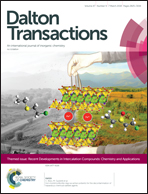Pillaring of layered zeolite precursors with ferrierite topology leading to unusual molecular sieves on the micro/mesoporous border
Abstract
Layered zeolite materials with FER layer topology can produce various condensed and expanded structures including zeolite frameworks, FER and CDO, their interlayer expanded forms (IEZ), and organic-intercalated and pillared derivatives. This work concerns pillaring of the surfactant-swollen derivative with a gallery height of ca. 2.5 nm between layers by treatment with tetraethylorthosilicate (TEOS) at room and elevated temperatures. The materials obtained at 100 °C and higher showed unusual properties including 2 nm pores on the micro/mesoporous border and disordered layer packing indicated by the absence of distinct low angle interlayer peaks at d-spacing >3 nm (∼3° 2θ Cu Kα radiation) in the X-ray diffraction pattern (XRD). TEOS treatment at room temperature produced a pillared molecular sieve with the expected mesoporous characteristics, namely a pore size of around 3 nm and a high intensity low angle (001) peak at 2.3° 2θ, and a d-spacing of 3.8 nm, in the XRD. The characterization aiming to elucidate the nature of the obtained unusual products included gas adsorption isotherms, aberration corrected (Cs-corrected) Scanning Transmission Electron Microscopy (STEM) studies and 29Si solid state NMR. BET surface area values decreased with the temperature of TEOS treatment from approximately 1200 m2 g−1 to ∼900 and 600 m2 g−1, at room temperature, 100 °C, and 120 °C, respectively. The 29Si solid state NMR revealed the presence of both Q3 ((SiO)3SiOX, X = H or minus charge) and Q4 ((SiO)4Si) centers giving separated signals up to the pillaring step. After pillaring at 100 °C and calcination, the nominal intensity ratios Q4 : Q3 were 2.17 and 2.61 but the signals were merged into one broad peak indicating the structural heterogeneity of Si–O coordination. The microscopy showed the presence of FER layers in the samples but the overall structure and composition were not well-defined. The observed unusual disorganization and possible partial degradation of layers during pillaring may result from the combination of high temperature, alkalinity (surfactant hydroxide) and siliceous composition of the layers. The obtained pillared products are of interest for the preparation of larger pore catalysts and sorbents or controlled drug delivery.

- This article is part of the themed collection: Recent Developments in Intercalation Compounds: Chemistry and Applications


 Please wait while we load your content...
Please wait while we load your content...